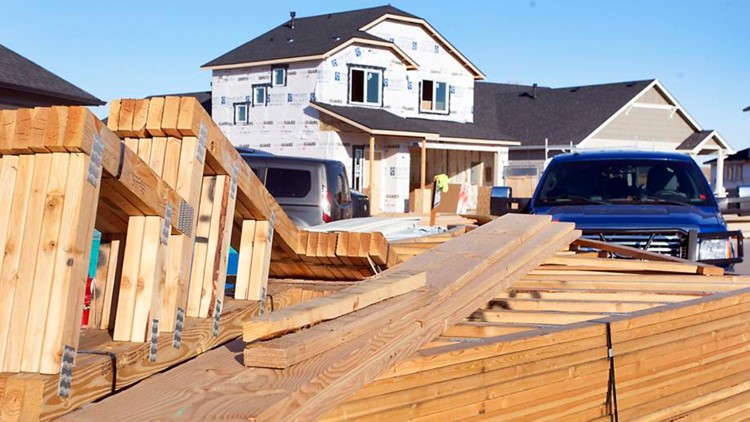BOISE, Idaho — Editor's Note: This article was originally published by the Idaho Press.
Ada County’s District 14 in Eagle has grown in population more than any other legislative district in the state, by far. It has nearly 36% more people than it should, so changes are in store.
As Idaho’s Citizens Commission for Reapportionment begins its work of drawing new legislative districts on Wednesday, the results will affect representation in the Legislature across the state, from the fast-growing Treasure Valley, which is due to gain a district, to far-flung rural areas that stand to see their legislative districts grow, potentially reducing their representation.
“It’s always one area loses a district so that another area gains it,” said Matthew May, a senior research associate with the Idaho Policy Institute at Boise State University who studies redistricting. The total number of legislative districts is fixed at 35.
The redrawing of district lines also raises the possibility that one or more new districts could cross the Ada-Canyon county line, which no legislative districts do now.
House Majority Leader Mike Moyle, R-Star, who represents District 14, said, “If they don’t, you’re going to have two districts like mine is now in just a couple years.”
Canyon County currently is split in District 9, which takes in part of Canyon County along with Adams, Payette and Washington counties. Ada County isn’t split, meaning currently, all its districts are contained within the county.
District 14, which takes in Eagle, Star, part of Meridian and some parts of unincorporated Ada County, has 71,366 residents, according to the latest U.S. Census figures. That’s 18,820 higher than the ideal district population for the next redistricting cycle of 52,546.
Yet, when the district was drawn 10 years ago, it was nearly dead-on for the ideal population, going over by just under one-third of a percentage point. That came after the district also was the fastest-growing district in the state a decade ago.
“District 14 was the highest population last time as well,” May said. “It was almost the size of two districts last time. … It’s still the most populous district in the state, now two redistricting cycles in a row.”
“That certainly highlights the fact that that is one of the most fast-growing areas in the state, just the fact that it’s been able to sustain that level of growth decades apart,” he said.
Districts must be drawn to be as close as possible to equal in population, to preserve the one-person, one-vote principle. But the citizens commission also is guided by state and federal constitutional and legal requirements to avoid splitting counties unnecessarily; to keep districts contiguous; to preserve communities of interest; and more.
Unlike congressional districts, which must be as close to absolutely equal in population as possible, courts have indicated that some variation between legislative districts is allowed. It can’t, however, exceed a 10% difference in population between the largest and smallest districts. That means if Idaho’s new largest district is 4% over the ideal population, the smallest could be no more than 6% under.
There are a number of different ways the citizens commission could solve the District 14 problem. One would be to draw a new cross-county district that combines Star, in Ada County, with Middleton, in Canyon County. Both are similar-sized growing cities in otherwise rural areas. District 14 currently butts up against District 11 in Canyon County, a sweeping C-shaped district that takes in Middleton, swoops around the western part of the county including the Greenleaf area, and then includes all of southern Canyon County.
Its three current lawmakers are Reps. Tammy Nichols, R-Middleton, and Scott Syme, R-Caldwell; and Sen. Patti Anne Lodge, R-Huston.
District 14’s current lawmakers are Moyle; Rep. Gayann DeMordaunt, R-Eagle; and Sen. C. Scott Grow, R-Eagle.
“I don’t have any issue with the current district,” said Star Mayor Trevor Chadwick. “It’s going to be interesting to see.”
Middleton Mayor Steve Rule said, “Legislative district in this case is different from reality for us, because of tax collection, police districts, school districts, fire districts, things like that.” Various disputes on those questions are “likely headed to court between Star vs. Middleton, Canyon County and Nampa, so I really can’t comment on it,” he said.
Star has actually already crossed the county line and grown into Canyon County, a move nearby Middleton bristled at.
“There’s some disputes there,” Chadwick said. But as far as legislative district lines, if Star stayed with mostly Ada County areas, or joined some in Canyon, “Either way, I don’t think there’d be an issue with it, as long as there’s equal representation of our city,” he said. “We’ve been so tied in with Eagle for so long, even with our schoolchildren and all that stuff, so it just kind of makes sense to keep all those together.”
He noted, “If it was with Middleton, we’re pretty equal in size with the population. We’re about a third the size of Eagle, maybe half now. … I think we’ll have plenty of representation for the citizens.”
Whatever the new district’s boundaries for the area, Chadwick said, lawmakers seeking to represent it will need to court voters in each of the communities, including his, in order to get elected.
“I think this is going to work out either way for us, whichever direction it goes,” he said.
Moyle recalled, “Years ago, when I first ran, District 14 I think ran all the way to Cascade, and then I had Kuna too and part of Garden City.”
“I hope that some of the districts … in fast-growing areas of the state, that they make those a little on the low end, so they catch up,” he said. “If not, those people are going to be way under-represented in 10 years.”
Idaho district lines are drawn by a six-member citizens commission that’s equally split between the two political parties. In order to agree on a plan, they have to work together.
Since the last Census, Ada County’s population has grown by 26.1%, and Canyon County’s by 22.3%. Kootenai County in North Idaho grew by 23.7%; and Madison County in eastern Idaho grew by a whopping 41%, though its population is only about a tenth of Ada’s.
May said those centers of growth – in the Treasure Valley, in North Idaho and in eastern Idaho – will generally gain representation while slower-growing, more rural parts of the state will lose in the redistricting process. Four Idaho counties actually lost population since the last Census, all in rural areas.
Keith Bybee, project manager and staffer for the redistricting commission, said, “The Treasure Valley is picking up a whole district at least.”
Complicating this year’s process is the pandemic-caused delay in receiving final Census data, leaving the commission just a short window to draw new district lines, withstand any legal challenges, and have them in place in time for the May primary election.
“They have a huge puzzle to put together, and it’s so late in the game that they’ve got a lot of work to get done before the start of this next session,” Chadwick said. “I wish them luck.”
Moyle said with Ada County’s growth, it’d likely be difficult to contain all its districts strictly within the county lines. “It doesn’t make sense to try to stuff a third of a district into Ada County,” he said. “There’s going to have to be some county-line overlap.”
“I love my district,” he said. “When it comes to redistricting, I’m glad that they’re doing it and not me. It can’t be easy.”
Betsy Z. Russell is the Boise bureau chief and state capitol reporter for the Idaho Press and Adams Publishing Group. Follow her on Twitter at @BetsyZRussell.



